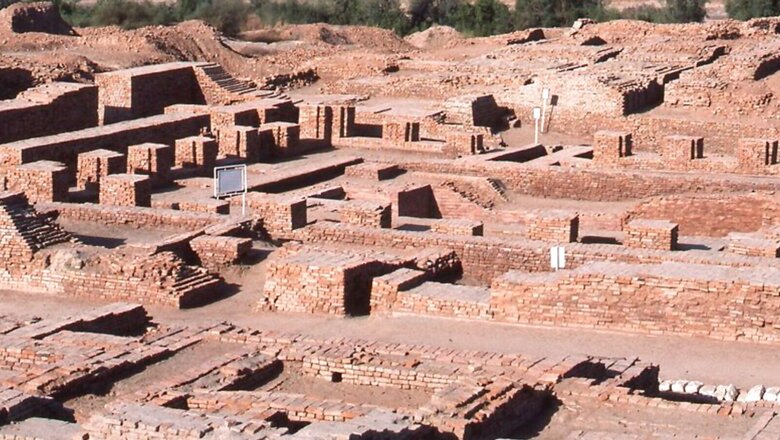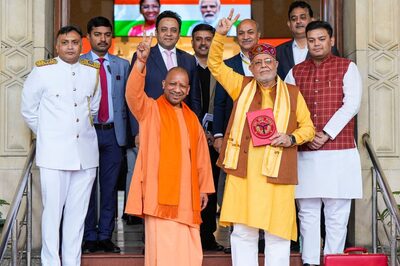
views
The Sindhu Sarasvati Civilisation (SSC) declined around 1900 BCE. Early historians termed the decline as a collapse or extinction. The general consensus was that SSC ended as a result of a catastrophic event like an invasion by horse-riding Aryans. This line of thought gave rise to the Aryan Invasion Theory. The theory has since been discredited in absence of any credible physical evidence. Modern technologies like satellite imaging, palaeo-climate data, and underwater archaeology have helped us understand the real cause of the SSC’s decline.
The general consensus now points to climate change and tectonic movements as a cause of the decline. A prolonged period of weak monsoon made it difficult to sustain the summer crop in the Sindhu-Sarasvati region. A sudden tectonic shift, probably due to an earthquake, led to a change in the course of Sutlej, which fed the Sarasvati river. The change in the course of Sutlej led it to become a tributary of Indus instead of Sarasvati. This caused havoc in two regions. First, the Sarasvati, once a mighty perennial river, was now reduced to a much weaker seasonal river. The Indus on the other hand received huge amounts of water from Sutlej, probably flooding a large area in its basin. Life around both rivers got adversely impacted, leading up to a decline in population.
The SSC definitely saw a decline, but did it also see a collapse or extinction as proposed by some historians? The answer is, no. The accepted way to define a civilisation in academia is to identify it with the material culture of the place, especially in absence of any literary sources. In the case of the SSC, the civilisation was defined by its material culture like pottery, script, seals, town planning, buildings and houses, and so on. These were the common threads that connected all the sites excavated along the Indus and Sarasvati. After 1900 BCE these common elements became less evident and disappeared completely, thus marking the end or extinction of the SSC.
But what about the intangible culture of the people of SSC? Was it considered by the archaeologists or historians? Does a decline in material culture alone mark the end of a civilisation? To be honest, it is unfair to blame the archaeologists for not considering the intangible culture of SSC. Their job is strictly that of excavating material evidence and presenting it to historians for interpretation. The early historians on the other hand did not do a good job. The post-Independence India was going through a flux in the field of history. The Aryan Invasion Theory was being accepted and propagated in textbooks. The Aryan-Dravidian divide was fuelling identity politics in southern India, Tamil Nadu to be precise. Attempts were made to discredit nationalist historians (from the colonial point of view) and glorification of the Marxist version of history was in vogue. There was no attempt to understand the intangible culture of SSC, barring a few exceptions like BB Lal.
The intangible culture of SSC can be defined as the collective memory of its people as a civilisation. This would cover things that can be passed on from one generation to the next such as traditions, cultural values, religious practices, festivals, and so on. If we were to assess the extent of decline or extinction SSC suffered, we have to look at our cultural continuity. Are there cultural aspects that have continued and been passed on to us since the SSC times? The answer is, yes.
The most obvious evidence comes from the Swastika seals excavated at various sites of SSC. Even today no auspicious work is complete without drawing a Swastika. Such is the importance of Swastika that it was accepted into other faiths like Jainism and Buddhism. With Buddhism, the symbol travelled halfway around the world to Japan, where it is still used. Similarly seals with Peepal leaf have been excavated in many places. The importance of the Peepal tree in Hinduism and Buddhism is well known to us.
The fire altars excavated at some of the SSC sites are strikingly similar to the later Vedic altars. Burial practices in Rakhigarhi and Bhirrana, the largest and oldest of the SSC sites, are strikingly similar to the Vedic practices. Dr Amarendra Nath, former director at Archaeological Survey of India (ASI), has written extensively about this in his paper, ‘Harappan interments at Rakhigarhi, Haryana’, for Man and Environment, a journal published by the Indian Society for Prehistoric and Quaternary Studies. These are some of the intangible cultural aspects that we have inherited from the people of SSC over a period of almost 4,500 years.
Tangible or material culture also has plenty of evidence to support the hypothesis that the SSC never really went extinct. The finest example comes from the sculpture of the dancing girl at the national museum in Delhi. The girl stands with her right hand on her waist and a slightly bent left knee. Her left hand has a set of bangles reaching up to her armpits. Similar sets of bangles are still worn by women of the Banjara tribe in India. The bronze sculpture was cast using the lost wax technique, still used in both tribal and classical forms of metal casting across India.
Another fascinating artifact is that of the maze and ball toy. There are two versions of the toy displayed at the National Museum. One is circular and the other rectangular. Preserved in very good condition, the toy works exactly the same way as its modern, plastic versions. The circular disk has to be moved carefully to roll the ball into the groove in the centre. Then there is a plethora of string-pulled, wheeled animal toys. These were common until the advent of Western plastic toys. The modern die used for board games has remained unchanged for the past 4,500 years. Many cuboid terracotta dice have been excavated in SSC cities. The Diwali lamps that we buy every year are still made using the same technique of pinched lip, as in the SSC times.
The transition of SSC art, games, and material culture into modern times is perhaps an indication that all was not lost in the ruins of Indus and Sarasvati. Life carried on in a different place, in a different time. The material culture and part of our religious traditions are the gifts of Sarasvati that we still cherish.
The writer is a business consultant by profession and a history enthusiast by passion. He has published a book on ancient Indian history titled ‘Essays on Indic History’. The views expressed in this article are those of the author and do not represent the stand of this publication.
Read all the Latest Opinions here


















Comments
0 comment